Salon
BagNews Salon: The Fall of Bin Laden
The BagNews Salon in collaboration with Open-i, brought together photographers and visual academics to analyze photos of Osama Bin Laden’s death.
The demise of bin Laden was momentous, as anticipated as it had been for almost ten years. It also turned out to be a huge photo story, but in ways we probably wouldn’t have anticipated: the security room photo led to days of analysis throughout the internet and the debate over whether to release pictures of Osama bin Laden’s corpse was significant, as well as the movies and stills released by the Department of Defense that bin Laden had taken himself.
In approaching the story with a month’s perspective, we discussed how it was visualized by the government and the media as well as by the two photographers that covered the story.
Watch the full archive or read salient quotes from the conversation below.
Open-i
Co-Produced for BagNews by Ida Benedetto
Images and Selected Quotes:
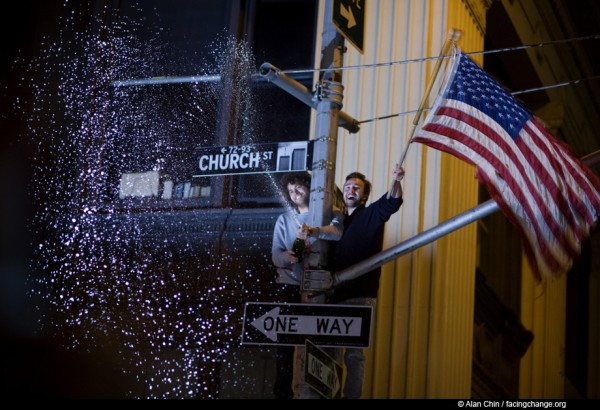
(photo: Alan Chin / Facing Change. caption: Ground Zero Celebration.)
Alan: The [Ground Zero] crowd was incredibly raucous…they were climbing lamp posts, waving flags, drinking heavily, and having what looks like a frat party. These people were ten years old ten years ago. It was pretty amazing that the police didn’t even stop them…they seemed very content to let this all kind of explode.
There was another guy who said, “what we need is a sailor and a nurse.” Of course what he was referencing was the famous V-J photo by Alfred Eisenstaedt in 1945. Maybe this generation wants to feel something that powerful.
Loret: One of the things I find remarkable is the response that people had [to 9/11 photographs] does seem to echo responses to iconic images they’ve seen before. They are not the same. Are younger people borrowing iconography instead of really trying to understand what’s going on now?
Alan: We continue to look for iconic images. As a photographer, I’m doing it as much as anyone. Maybe more so. But I ended this evening feeling quite disgusted and didn’t know what to do about it.
…
People in this generation have felt very distant from these wars. There is no draft, not even a large call for volunteers. People know there’s a war out there and they want to be a part of it even though they are really not. So they perform.
Kenny: In the age of the “always on,” I think that there’s a serious critique to be stated about where authentic experiences take place, but in its place, with what went down.
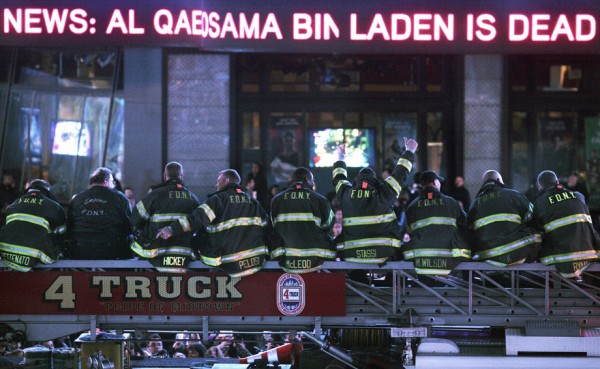
(photo: Michael Appleton. caption: Firefighters in Times Square.)
Michael A: It slowly built, this group of people in Times Square. This fire truck arrives and I made this picture. In a strange way this photograph is an anomaly for that evening. It’s a moment of reflection on an evening strangely like a wild party.
Cara: One of the interesting things about this photo is the names of the firefighters on their jackets. It echoes the specificity of their loss on 9/11.
Jared: Your eye is immediately attracted to the news banner and then to the firefighters. Directly below the banner you can see a swarm of photographers trying to capture the moment. Those guys are fighting for the perfect shot. …(H)aving those guys down there really describes what a media moment this is apart from a moment for the country.
Michael A: [This company] lost 15 firefighters on 9/11. They have a direct connection to this story. Physically, they are at an elevation … above the crowd and that speaks to the fact that their connection to the story is probably greater than those below them.

(photo: ABC. caption: Bin Laden bedroom photo.)
Alan: What struck me about the images of Abbottabad in Pakistan and this house is that, contrary to what we were told, that this is a million dollar house, it’s not. It’s a typical middle class, maybe upper middle class scene. Not a hut or a cave, but it’s certainly not the lap of luxury.
Kenny: It seems the government wants it both ways. One the one hand he’s in the lap of luxury and not representative of the Muslim masses, but on the other hand, he’s a pathetic guy living this non-special life.
These images are part of the insatiable appetite for images. It’s just a frame grab that offers some context and a sense of place. It doesn’t offer a lot of detail, but it gives the audience a vicarious appreciation for the details.
Michael: What’s been at the top of my mind about the coverage as one dominant theme is how much the attack on New York and bringing down the towers was a blow to the American ego. It seems to me that a lot of the coverage of bin Laden’s death is … almost an attempt to emasculate bin Laden or an attempt to show him as how someone who is hypersexual … as opposed to someone who adhered to Muslim values. So there was a lot of talk of how many wives he had and that he was with the youngest wife ….. and the fact that he had a porn collection. So … it’s very fascinating in a way, also very hard to look at and talk about, but so much of the American ego and emasculating bin Laden seems to be in a lot of these images. Even Alan’s picture of the guy shaking the champagne bottle is really almost ejaculatory.
Cara: One of the things I think is interesting about this photo and the next is the idea of a lack. That this photo is a picture of what we don’t have.
Loret: People just assumed and took this image to be evidence because it was the closest thing we had. It was something we needed to see; we wanted to see it. It became a substitute for the actual photograph of the body.
…
We don’t really have information and we don’t really know what the photograph is…..were they going to bed at the time, was the bed messed up as the body was removed? We just have this image and that’s why it’s somehow seems particularly vague, particularly brutal, and intrusive.
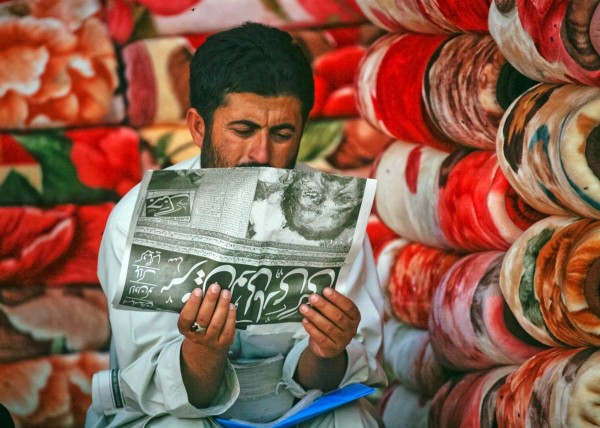
(photo: Naseer Ahmed / Reuters. caption: Man and Photoshop.)
Jared: [Senator] Scott Brown had spoken to Fox News that he had seen the [Photoshopped] photos and he could personally guarantee that bin Laden was dead. I remember calling, because he’s on the [Senate] Armed Services Committee, to see who else might have had access to the [photoshopped] photo. And a bunch of staffers in his local congressional office, one of them said, “I think this is Photoshopped, I’ve seen it everywhere.” It was intriguing how many young people in his office knew it was a Photoshop and just let him believe what he wanted to believe in regard to its veracity.
Michael: So many senators felt compelled to talk to the press about seeing the actual photo and the set of ten including the one of the washing of the body and then the depositing of it in the ocean. There’s the whole issue of whether or not they should have released the photo and then there’s this sub-issue that had to do with this tease where these senators talked to the press about the photo. It’s one thing to say “O.K., this photo should stay out of the public realm,” but it’s another thing to talk to media left and right and describing the photo. I don’t think that was fair.
Alan: What strikes me about this Photoshop stuff is that in a way they get to have their cake and eat it too. Even though these are fake pictures, a lot of people, like the guy reading this newspaper in this photo or other people like the senators might not necessarily care or know that it was Photoshopped. They’ll believe it. It kind of serves that evidentiary function even though it was immediately known that it was fake. It doesn’t matter that it was fake, it’s already out there. They don’t have to release the real photo, but at the same time the fake photos serve the same purpose in terms of the thing that people want to believe.
Cara: I read this image as: Is this guy the dupe that stands in for everybody and what does it mean that he’s Pakistani?
Loret: The Photoshop photo is very similar to the bed photograph. If you can’t see the real thing then this is a reasonable substitute. It seems to be that people wanted to see an actual photograph. If you can’t have the actual thing, then this is good enough whether it’s the bed photo or the Photoshop of bin Laden’s body.
Lindsay: I wonder if this man is sad about bin Laden or sad about what’s going to happen in Pakistan or both?
Kenny: The Photoshop photo has done its job and its job has been to offer some deception or uncertainty into the mainstream and further exacerbate the questions that are out there. False photographs are not new in the lexicon of photography. What’s new now is the speed and the kind of precision and lack of sophistication on the part of not just picture editors ….because most mainstream publications have eliminated picture editors and have untrained producers and copy editors and web producers who are making decisions and couldn’t tell you whether an image has been fabricated or not.
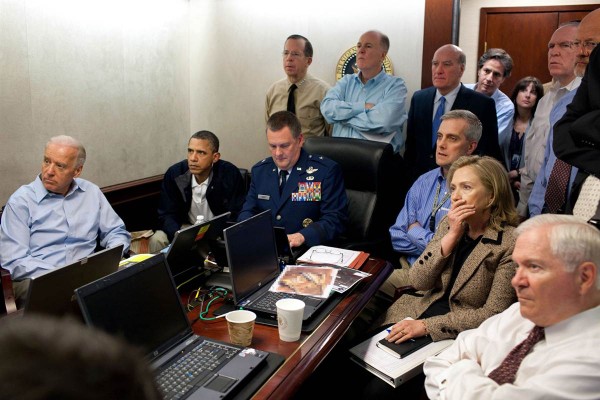
(photo: Pete Souza / White House. caption: The Situation Room.)
Jared: When I first saw this … I thought of how different this scene is from that specially set up photograph of President Bush with that Mission Accomplished sign behind him. Obama is not in the spotlight. He’s sort of off to the side. … It … emphasizes the sort of executive power Obama has been tried to convey. There’s a lot of humility. It’s not about him being strong and saving the country, it’s … a collective effort of agencies and we have this menagerie of officials here who are really making up the scene.
Kenny: The Flickr effect has been an intentional organizational decision by the Obama Administration to circumvent the mainstream media. They are clearly aware that mainstream media would much rather have their own representatives providing this work, but … the Administration is not going to allow that to happen. You get the picture quicker through Flickr than waiting for the picture to be released from the White House to news agencies.
Pete: When Pete Souza released this on Flickr, his words were “an image of the security staff receiving an update from the mission.” And I wrote a piece shortly afterward because I’d been kind of flummoxed that throughout the entire media, “receiving an update” became “watching a live feed of the raid.” So I don’t know if that’s accurate information. But it’s my suspicion that this photograph again serves reporters but also serves the consumer. And that caption that these people are watching in real time Osama bin Laden being killed is so seductive that no one challenged it.
Justin: One of my colleagues at Salon did a piece putting together the various descriptions of what they looking at from different Administration officials and they differed pretty widely. For example, Jay Carney, the press secretary, said they were getting “minute-by-minute updates,” but Leon Panetta, the CIA Director, said at one point that there were 20-25 minutes when they couldn’t see anything that was going on. The latest piece of information I saw on it is an AP article from a few weeks ago in which they quoted anonymous sources as saying that what they were looking at was more of an aerial shot of the compound from some sort of satellite. It’s still entirely unclear. There’s no official explanation for what they were looking at.
Loret: This photograph shows how the public will look at individual expressions so closely, if they have some idea of something going on and if they are imaging what’s going on.
Cara: One of the things I love about this photo is that it relies so much on the viewers’ imagination to construct a narrative imagining not only what people are looking at but what they are thinking. It’s so multiply referential it almost makes one dizzy to think about it.
Justin: Where the other people look intensely focused, Hillary Clinton almost looks overwhelmed. Obviously, it’s going to be an iconic photo. I wonder what her feelings are about this photo and how it portrays her at this moment as almost being overwhelmed. It almost makes the photo. When you look at the high resolution version of the photo, Obama is a bit out of focus. Where Hillary is kind of sharp, Obama is a little fuzzy.
Alan: If we can trust the caption that it was during the operation, it doesn’t really matter exactly which second they’re watching, the key moment is the successful killing of bin Laden. It could be any of 10,000 different pieces of the puzzle. Visually and emotionally it doesn’t really matter which one. This is the image that now visually, iconically, will stand in for the whole experience.
Pete: I don’t want to sound too cynical, but my conclusion with the Situation Room photo is that it is the greatest piece of PR the White House has ever delivered.
Loret: We don’t know exactly what they are looking at, but they are all concerned. They are all seriously engaged. All of the elements are carefully arranged. I trust Pete Souza’s reputation and character, but if I didn’t know the photographer, I would look at that photograph and it’s almost as if somebody said “could you move your head a little bit left or right” or something like that.
My concern is that that there is no context. We consume photographs like we consume popcorn. People are bombarded with this stuff but there are a lot of people who don’t read captions or look behind the picture. What is the future for a photographer having authenticity and transparency?
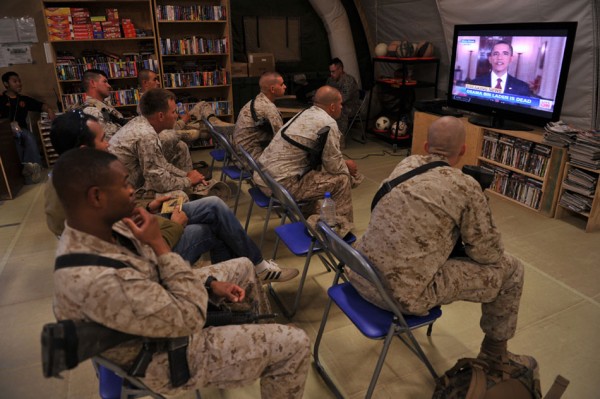
(photo: Bay Ismoyo / Getty Images. caption: Marines Watching Obama Announcement.)
Justin: I was struck by the soldiers’ indifference displayed in this photo and I think that speaks to this event and its relation to Afghanistan and how it really doesn’t change anything on the ground certainly in the short term for these soldiers.
Loret: There’s something so strange about this photograph in terms of what it says about contemporary warfare. Whether it’s the large flat screen TV or the sports balls, DVDs, magazines, books, etc. but this is a very, very different image of warfare than we’ve seen in traditional media before. Everybody’s got a gun, but they’re in something that looks like a rumpus room. These guys have to be thinking about bin Laden’s death means, too, and I suspect they have a lot clearer idea that it doesn’t mean “Mission Accomplished.”
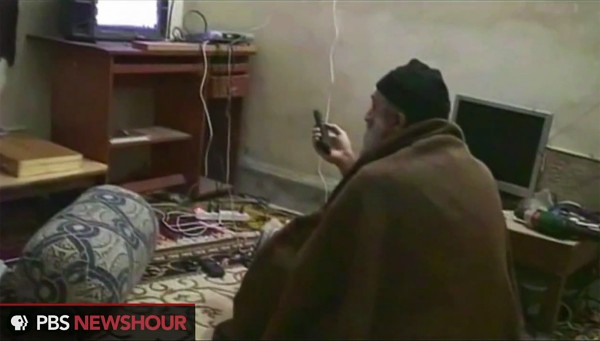
(photo: PBS News Hour. caption: Osama bin Laden video still.)
Pete: I remember seeing one piece of commentary that broke down the elements in this image, noting the flat screen TV over his shoulder. And the caption read: “Osama bin Laden with access to high tech equipment.” I thought that was salacious and nonsense. He’s got a set up with a TV and a box and a computer like that wouldn’t be expected of any household or compound anywhere in the world. I think we continue to read into this in ways that the American government hoped we would with the release of these images. Of all the images we are looking at tonight, it’s one that we can read too much into and over-interpret.
Alan: At the same, it’s a reminder, at least in theory, how much you can do with low tech. All you need is a cell phone and an internet connection and not even an internet connection in the house since he relied on couriers. It’s all you really need.
Loret: I was struck by how many photographs in the edit are people watching screens. Even the firemen are watching a crawling screen. And here we have Osama bin Laden looking at a screen. It’s just a pervasiveness of how we understand our world. I think it’s especially interesting that the very last photograph in this particular edit shows also a very large screen — though people are ignoring it.
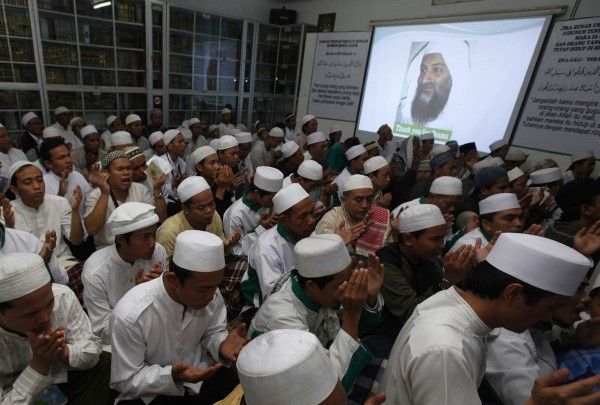
(photo: Reuters. caption: Prayers for Osama bin Laden.)
Alan: The fact that they are not looking at the screen in this photo, but rather separately engaged shows that he’s a symbol for these men, but not more than that, not a reality but a symbol.
Closing Conversation: What Did We Actually See?
Pete: Following up on the descriptions of the screen and the pervasiveness of the image, doesn’t all of this tie into the final debate: Do we or do we not want to see images of Osama bin Laden’s corpse? Even if it’s presented, just like the fake photograph, are we still going to maintain the position that is most comforting to us? So there is some irony that all of these pictures have involve screens and people looking at screens and images of images but that the one image that captures everyone’s attention is still totally absent.
Alan: This Administration, despite the use of Flickr and all these other tools, is the most closed off Administration ever from the press and from scrutiny. So we photograph the screen rather than photograph the thing itself because you either can’t be there or you’re not allowed access and we’ve replaced really being there with the next best thing. The next best thing really isn’t that great at all. Where are the pictures of the dead bin Laden? Why wasn’t there a photographer embedded with this mission? One asks these questions and all the answers are in the negative.
Michael: Maybe it’s a bit of a distraction game that we are asking why we didn’t get to see this one photo when the real question may be: What did we actually get to see in the first place? All this imagery is so mediated. We don’t see dead bodies and we don’t see what’s happening on the ground in Afghanistan – the war reporting, the visual reporting is really human interest stories, if that, and Dover Air Force Base was shut off to us for so long. So maybe it’s a straw man, that question, and points to a much larger issue.
Pete: It’s been said many times, but I think the reason BagNews won the award for Michael Kamber’s slide show is because he said it so succinctly: that is all you’ve got, and the rules and restrictions on embeds are getting tighter and tighter.
Whenever I talk about the Iraq War, I say the most significant images f… were those from Abu Ghraib and they were taken by soldiers who wanted to protect themselves against future court martial. That failed. It seems that nowadays we talk about photography in a way that’s very anxious and it’s an anxiety that reflects our dislocation and our uncertainty about global relations.
Michael: These wars are actually fought through the airwaves as much as on the ground and it’s so much of that perception and spin. I think the Arab Spring has shown us that and brought that into a lot of clarity. It actually throws even more weight on the imagery and access to imagery.
Alan: I think … more and more that we are not going to bring the truth or the standard or the conventional wisdom…. I think the market creates that on its own. My job as a photographer ultimately, and in the end of the day, is just to make a historical record.
The Full Edit
Take a closer look at some of the images from our larger photo edit.








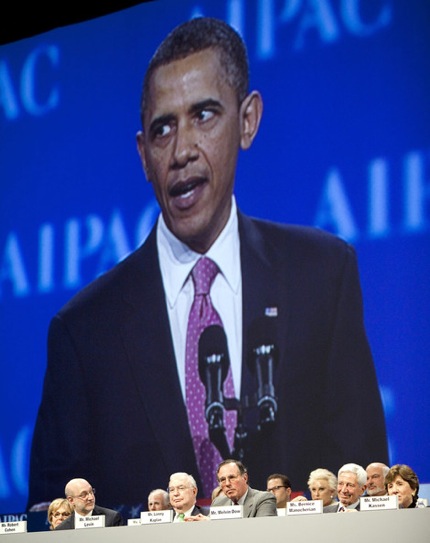
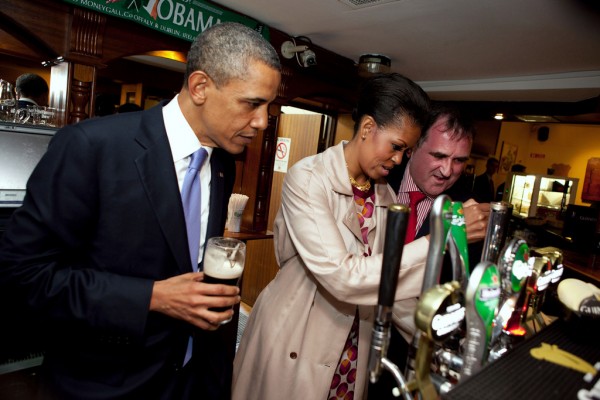
Reactions
Comments Powered by Disqus